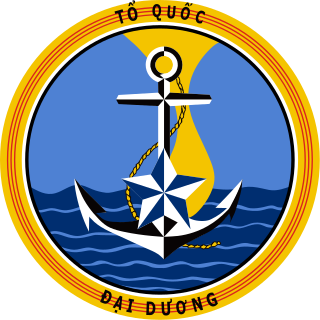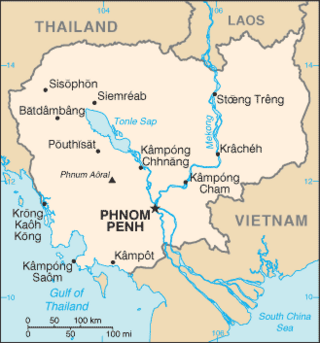Related Research Articles

The Vietnam War was a conflict in Vietnam, Laos, and Cambodia from 1 November 1955 to the fall of Saigon on 30 April 1975. It was the second of the Indochina Wars and a major conflict of the Cold War. While the war was officially fought between North Vietnam and South Vietnam, the north was supported by the Soviet Union, China, and other countries in the Eastern Bloc, while the south was supported by the US and anti-communist allies. This made it a proxy war between the US and Soviet Union. It lasted almost 20 years, with direct US military involvement ending in 1973. The conflict spilled into the Laotian and Cambodian civil wars, which ended with all three countries becoming communist in 1975.

The Army of the Republic of Vietnam composed the ground forces of the South Vietnamese military from its inception in 1955 to the Fall of Saigon in April 1975. At the ARVN's peak, an estimated 1 in 9 citizens of South Vietnam were enlisted, composed of Regular Forces and the more voluntary Regional Forces and the Popular Force militias. It is estimated to have suffered 1,394,000 casualties during the Vietnam War.

The Khmer Republic was a Cambodian state under the United States-backed military dictatorship of Marshal Lon Nol from 1970 to 1975. Its establishment was formally declared on 9 October 1970, following the 18 March 1970 coup d'état which saw the overthrow of Norodom Sihanouk's government and the abolishment of the Cambodian monarchy.

The Cambodian Civil War was a civil war in Cambodia fought between the forces of the Communist Party of Kampuchea against the government forces of the Kingdom of Cambodia and, after October 1970, the Khmer Republic, which had succeeded the kingdom.

The Cambodian–Vietnamese War was an armed conflict between Democratic Kampuchea, controlled by Pol Pot's Khmer Rouge, and the Socialist Republic of Vietnam. The war began with repeated attacks by the Liberation Army of Kampuchea on the southwestern border of Vietnam, particularly the Ba Chúc massacre which resulted in the deaths of over 3,000 Vietnamese civilians. On 23 December 1978, 10 out of 19 of the Khmer Rouge's military divisions opened fire along the border with Vietnam with the goal of invading the Vietnamese provinces of Đồng Tháp, An Giang and Kiên Giang. On 25 December 1978, Vietnam launched a full-scale invasion of Kampuchea, occupying the country in two weeks and removing the government of the Communist Party of Kampuchea from power. In doing so, Vietnam put an ultimate stop to the Cambodian genocide, which had most likely killed between 1.2 million and 2.8 million people — or between 13 and 30 percent of the country’s population.

The Republic of Vietnam Navy (RVNN; Vietnamese: Hải quân Việt Nam Cộng hòa - HQVNCH; was the naval branch of the South Vietnamese military, the official armed forces of the former Republic of Vietnam from 1955 to 1975. The early fleet consisted of boats from France; after 1955, and the transfer of the armed forces to Vietnamese control, the fleet was supplied from the United States. With American assistance, in 1972 the VNN became the largest Southeast Asian navy and, by some estimates, the fourth largest navy in the world, just behind the Soviet Union, the United States and the People's Republic of China, with 42,000 personnel, 672 amphibious ships and craft, 20 mine warfare vessels, 450 patrol craft, 56 service craft, and 242 junks. Other sources state that VNN was the ninth largest navy in the world. The Republic of Vietnam Navy was responsible for the protection of the country's national waters, islands, and interests of its maritime economy, as well as for the co-ordination of maritime police, customs service and the maritime border defence force.

Operation Menu was a covert United States Strategic Air Command (SAC) tactical bombing campaign conducted in eastern Cambodia from 18 March 1969 to 26 May 1970 as part of both the Vietnam War and the Cambodian Civil War. The targets of these attacks were sanctuaries and base areas of the People's Army of Vietnam and forces of the Viet Cong (VC), which used them for resupply, training, and resting between campaigns across the border in the Republic of Vietnam. The impact of the bombing campaign on the Khmer Rouge guerrillas, the PAVN, and Cambodian civilians in the bombed areas is disputed by historians.

The Khmer National Armed Forces were the official armed defense forces of the Khmer Republic, a short-lived state that existed from 1970 to 1975, known today as Cambodia. The FANK was the successor of the Royal Khmer Armed Forces which had been responsible for the defense of the previous Kingdom of Cambodia since its independence in 1953 from France.

Operation Chenla II or Chenla Two was a major military operation conducted by the Khmer National Armed Forces (FANK) during the Cambodian Civil War from 20 August until 3 December 1971.

The Sihanouk Trail was a logistical supply system in Cambodia used by the People's Army of Vietnam (PAVN) and its Viet Cong (VC) guerrillas during the Vietnam War (1960–1975). Between 1966 and 1970, this system operated in the same manner and served the same purposes as the much better known Ho Chi Minh trail which ran through the southeastern portion of the Kingdom of Laos. The name is of American derivation, since the North Vietnamese considered the system integral to the supply route mentioned above. U.S. attempts to interdict this system began in 1969.
Operation Freedom Deal was a military campaign led by the United States Seventh Air Force, taking place in Cambodia between 19 May 1970 and 15 August 1973. Part of the larger Vietnam War and the Cambodian Civil War, the goal of the operation was to provide air support and interdiction in the region. Launched by President Richard Nixon as a follow-up to the earlier ground invasion during the Cambodian Campaign, the initial targets of the operation were the base areas and border sanctuaries of the People's Army of Vietnam (PAVN) and the Viet Cong (VC).
The CIA conducted secret operations in Cambodia and Laos for eight years as part of the conflict against Communist North Vietnam.
Um Savuth was a Cambodian army officer who came to his greatest prominence during the Cambodian Civil War, where he was responsible for commanding the Khmer National Armed Forces during their disastrous 1971 offensive, Operation Chenla I. The son of a government chauffeur, and the younger brother of politician Um Samuth, Savuth began his career in the Royal Cambodian Army under the regime of Prince Norodom Sihanouk, and became a supporter of General Lon Nol after the latter's 1970 coup against Sihanouk.

The Cambodian Marine Corps or Corps de Fusiliers-Marins Khmères (CFMK) in French, were the Naval Infantry branch of the Khmer National Navy during the 1970-75 Cambodian Civil War.

The Vietnam War involved many countries across the world. North Vietnam received support from the Eastern Bloc, while South Vietnam was generally supported by nations of the Western Bloc.
References
- ↑ Wilfred P. Deac (December 1996). "Losing Ground to the Khmer Rouge". Vietnam Magazine.
- ↑ "USS John Paul Jones DD 932, Mesothelioma and Asbestos Exposure". Archived from the original on 2010-12-06. Retrieved 2010-07-23.
- 1 2 3 4 5 6 7 8 9 "Vietnam Archive Operations Database". The Vietnam Center and Archive.
- ↑ Sherwood, John (2009). Nixon's Trident: Naval Power in Southeast Asia, 1968–1972. Naval History and Heritage Command. p. 75. ISBN 978-0-945274582.
- ↑ Lavalle, Maj. AC (1976). Airpower and the 1972 Spring Invasion (PDF). Maxwell AFB AL: Air University Press.
- ↑ Kissinger, Henry (11 February 2003). Ending the Vietnam War: A History of America's Involvement in and Extrication . Simon & Schuster Ltd. p. 350. ISBN 978-0-7432-1532-9.